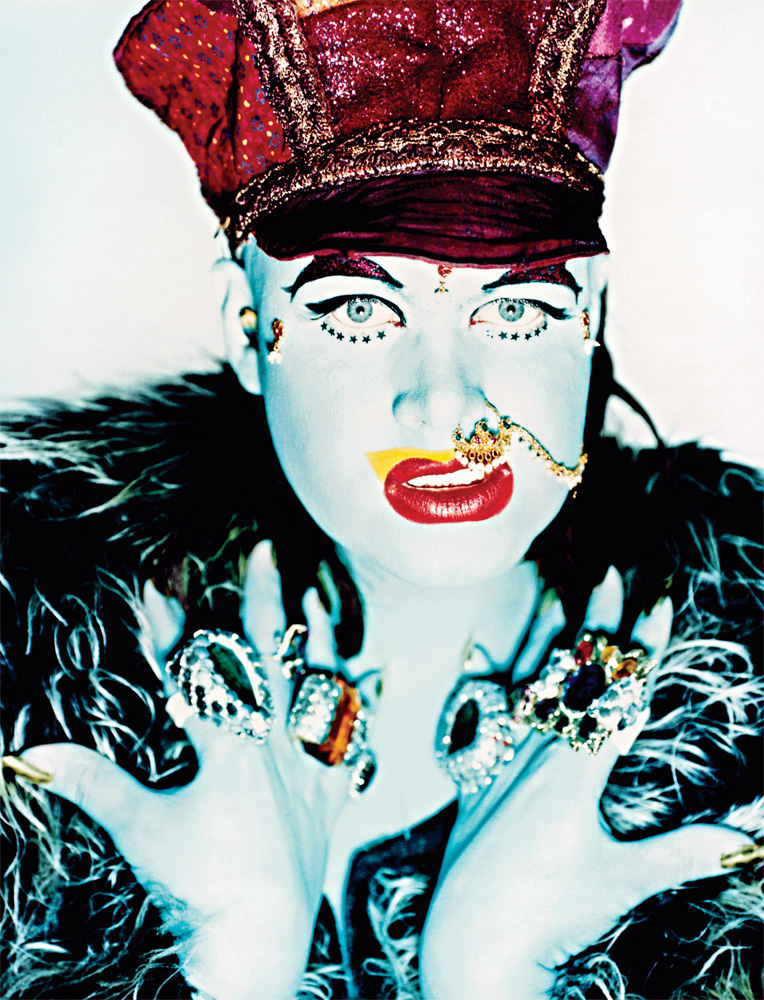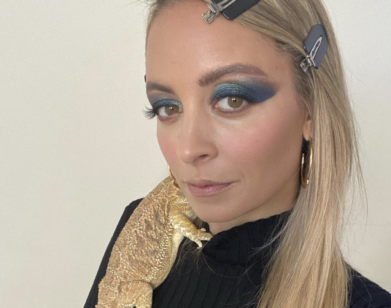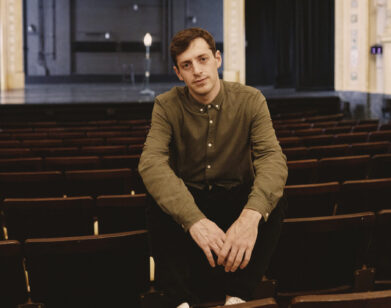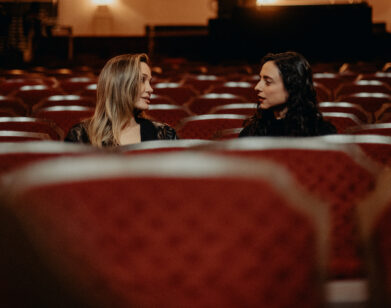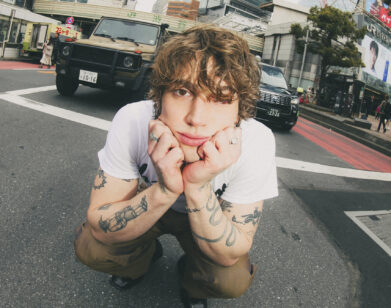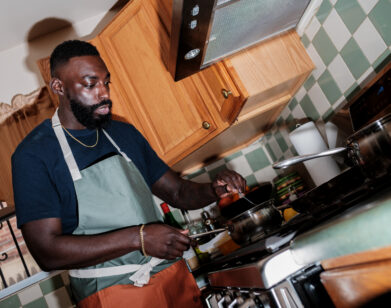Taboo
Before Leigh Bowery and his mid-’80s London club night came along, being a freak was not considered a fine art form. Pop star and DJ Boy George remembers the legendary scene where glamorous polysexual debauchery and head-to-toe body makeup went along with the music.
“Dress as though your life depends on it or don’t bother,” Leigh Bowery notoriously said when describing the code of attire for his night on Thursdays at a club called Maximus off of London’s Leicester Square. The year was 1985, and Bowery’s venture into what had become a rather dull nightlife scene in London was called Taboo. Taboo and its radically subversive, pro-weird crowd not only drew upon the playful, decadent androgyny of the New -Romantic scene, then holding sway among London’s cooler contingents—it took those aesthetics, dipped them in plastic, vinyl, or Dalmatian-spotted fake fur, smeared profuse amounts of cartoonish body makeup on them, and strung them out on a dance floor to revel in all their freakish (and often drug-fueled) psycho-glamour. Taboo existed only from 1985 to 1986 (when the police finally shut it down), but it turned Bowery into an eternal cult figure and redefined what nightlife was to look like (New York’s campy and, eventually, bloody version, Disco 2000, was heavily inspired by Taboo). Boy George, who went on to celebrate Leigh and his gang in the 2002 musical Taboo, was not only one of Bowery’s friends, he was a regular at the party—an “elder statesman” as he likes to think of it. Here the 47-year-old musician remembers the British subcultures that led up to Bowery and the raucous nights where the only rules were that there weren’t any.
MARK RONSON: I wish we could do this in person, but obviously we can’t . . .
BOY GEORGE: No, they won’t let me come to America. [laughs]
MR: Are you not allowed?
BG: I’ve got to deal with some legal things. But hopefully next year . . . [At press time, Boy George was on trial in London courts on charges of false imprisonment.]
The Taboo crowd was happy to end up in a pile of vomit and booze at the end of the night.
It was antifashion, in a sense. They were just as obsessive as the New Romantics but they acted
like they didn’t care.Boy George
MR: When was the last time you were here?
BG: The last time I was there was when I swept up. [laughs] Is it still clean?
MR: Yeah, it’s amazing. You did a commendable job. [both laugh] I could pass a Boy George exam on what I know about your life. But I thought we’d just get to talking. I’ve only ever done an interview once before—with Malcolm McLaren.
BG: You know, I worked with Malcolm very briefly.
MR: That was something to do with you and Bow Wow Wow, right?
BG: Yeah, I was really good friends with Matthew Ashman, the guitarist in Bow Wow Wow. He died, unfortunately. He was one of my best friends during my sort of punk period. He was originally in Adam and the Ants before Malcolm stole the whole band. [laughs] Malcolm created Bow Wow Wow with Annabella Lwin, who was about 14 at the time . . . She was a baby. Anyway, I used to go to Malcolm’s all the time and we used to sing and piss around. He used to say, “God, you’ve really got a good voice. I wish you were in Bow Wow Wow.” I guess he thought, Why not bring in a drag queen? My first gig with that band was when they did a big concert at the Rainbow Theatre in Finsbury Park. I came on in the encore instead of Annabella and did an old Peanuts Wilson song called “Cast Iron Arm.” It was my first ever performance and I literally got pushed onstage. The audience was flummoxed, like, What the hell is this?
MR: Has your look quite evolved at that point?
BG: My look was actually more extreme. It was heavier makeup, more goth. I was in a skirt. Vivienne Westwood was there before I went onstage and she had all of these clothes from her Pirate collection, and she was trying to get me to wear them.
MR: The New Romantic look was very much -everything-and-the-kitchen-sink, right?
BG: Well, we didn’t have much money. So you’d maybe have a scarf or trousers or bits of designer stuff, and you’d mix it with junk-store stuff or things that you’d stolen or gotten from Oxfam shops. Everyone always had just a piece or two of Westwood—like a pirate hat.
MR: Your look was a bit goth, which later really got incorporated into the New Romantic look. But what specifically were you being influenced by in those years before Taboo?
BG: One of the most significant things at the time was a closing-down sale at this place called Charles H. Fox. It was a massive theatrical costumier’s. I remember all of us went to this clearance. It was all vintage, so we were really just getting our hands on different costumes. You know, the New Romantic scene was so tiny. Although it got lots of mileage in the media, it was a really small club with only a core group of people. As it got more popular, kids started to come from the suburbs all dressed up, but it -really wasn’t as big as it looked. But Fox’s clearance was a huge milestone in New Romantic style.
MR: Let me ask you about Warren Street. It was the infamous squat where you lived when you were coming up, right?
BG: Yeah. Warren Street was at the high end of the New Romantic scene. They were mostly college art students and people who knew top designers.
MR: So it really wasn’t squalor.
BG: No. There was one room on the third floor that was done very Grecian. It wasn’t squalor, but there wasn’t hot water and there wasn’t always electricity. But the people who lived there made it really good.
MR: I was watching the Joe Strummer film [Joe Strummer: The Future Is Unwritten (2007)] recently, and he talked about how he left the hippie thing
behind and decided he was a punk and started living in a squat. A lot of groundbreaking movements are born out of squat culture. It was something going on at the time.
BG: Oh, definitely. I was about 16 when punk started to happen. It was so exciting. You had a
social depression going on in the U.K. There was a sanitation strike. London was really grim, gray. You had Margaret Thatcher coming in. It was a really revolutionary time. It felt like you had this naïve idea that you could change things just by wearing something. [laughs]
MR: So punk was influential to you? Because with punk there’s a feeling that anyone could do this. But on the other hand you are a pure singer—
you have a beautiful voice.
BG: Certain punk bands were influential because I thought, If they can do that then I can . . .
Hanging around those bands was how I started my first band—In Praise of Lemmings.
MR: What was the next one called?
BG: Caravan Club.
MR: Then there was something with sex gangs . . .
BG: Oh, Sex Gang Children. One of the songs that Malcolm had written for me was “Sex Gang Children.” So I nicked the title. We changed the name from Sex Gang Children to Culture Club because Jon Moss, our drummer, went to L.A. on holiday and took some demo tapes with him. -Everyone loved the music but nobody liked the name. I -remember getting a postcard from Jon from L.A. saying, “I don’t think America’s ready for the Sex Gang Children.”
Leigh would make up stories about people committing suicide or going on hunger strikes because they were refused entry at the door.Boy George
MR: Were you surprised by the different scene in America?
BG: When I first went to New York, I didn’t really go out to clubs. It was the height of Culture Club so I didn’t really have a social life. It was only after I had been to New York a few times that I started going out. The most significant New York club for me was Paradise Garage, where they played house music. This was around ’84 or ’85.
MR: So this was right as Taboo was hitting.
BG: That was, of course, going on in London, so I’d go back and forth. Sometimes I’d even fly back for only a night.
MR: So you were more in New York at this point?
BG: Yes, but there was the Concorde.
MR: One of the unique things about Taboo was the way art and hedonism blended without seeming destructive.
BG: What happened was that the ecstasy thing hit London from New York. I was going to clubs like Area and Limelight and places like that in New York. London was going through a bit of a lull in terms of clubbing. Then Taboo opened. Leigh Bowery started it in 1985 . . . The first few weeks were no big deal. Then suddenly it was the place to be. There were queues outside.
MR: How was the Taboo scene different from the New Romantic scene?
BG: The Taboo scene was a kind of deconstructed version of the New Romantics. The Taboo crowd was using a lot of the visual ideas that had already been used. I remember the first time I spotted Leigh Bowery and Trojan parading around in clubs: They were in their “Pakis from Outer Space” look, and the makeup was quite similar to one of my old looks, because I was quite fond of wearing blue, green, or yellow foundation, and so I was pretty dismissive of them at first. On closer inspection, I realized that Leigh—who created the looks on his own for himself and Trojan—was a bit of a genius. It didn’t take Leigh long to be one of the most recognizable faces on the London club scene.
MR: Did you see yourself as an inspiration for Leigh in some ways?
BG: I wasn’t part of the Taboo crowd the same way I was part of the New Romantics. I suppose I was seen more as an elder statesman because I had been around the London club scene for so many years. To the Taboo crowd I was really seen as a pop star, someone famous. Leigh obviously loved having me in the club because I would attract media, and he loved and lived for his column inches. Leigh affected a posh English voice and elongated his vowels, and you never knew if he was being sincere or mocking you. If I ever commented on one of his outfits he would snip, “Oh, thank you, Mr. Boy George. I do value your opinion.” And then he would spin and make some ridiculous noise and mince off. At one point he created some stage clothes for me, and I went over to his flat in London’s East End to get them. I was rather taken with how charming and quirky he was in daylight. His flat was decorated much the same way as he dressed: with Star Trek wallpaper and mirrored walls and a huge piano in the living room. Everything about Leigh was -studied—it seemed he was willingly trapped in character 24 hours a day.
MR: Did the Taboo crowd make the New Romantics look like a bunch of Puritans?
BG: The Taboo crowd was certainly less precious. They were happy to end up in a pile of vomit and booze at the end of the night. It was antifashion, in a sense. They were just as obsessive as the New -Romantics but they acted like they didn’t care.
MR: It does seem, from the stories and the pictures, that the hedonism was way more insane than anything in New York. Even a place-to-be around that time like Studio 54 had nothing on it. It contained so much reckless abandon and was a lot more daring.
BG: I don’t know if it was that daring, it was just -really debauched. I think drugs played a big role in the Taboo scene. People were taking copious amounts of ecstasy, which had filtered over from New York, and at a certain point you were more likely to spend most of the night in the toilets at the club.
MR: Did Leigh Bowery enjoy his share of the -narcotic arts?
BG: I don’t think Leigh was a big drug user. He drank heavily, but he was more of a ringleader where bad behavior was concerned. He liked to create chaos around him, and with Taboo he created a scene where there were no rules. Of course there was still a fascist door policy. Some of the door bitches like Mark Vaultier would hold a mirror up to punters and say, “Would you let yourself in?” Leigh would create fake guest lists and put the most ridiculous names on them—Joan Collins, or really naff soap stars who would never grace the door of Taboo. Leigh would make up stories about people committing suicide or going on hunger strikes because they were refused entry at the door.
MR: Why was Leigh Bowery so fascinating to people?
BG: For me the most interesting thing about him was the way he used his body as a style statement. He was a big guy, but, because he was tall and had long legs, he looked in proportion—even sexy—-despite being overweight by conventional -standards. I -remember seeing him one night at a gay club called the Fruit Machine, which was always full of gym-toned muscle queens, and Leigh was naked except for a pair of big glitter knee-length boots and this puff-ball headdress that clearly impaired his vision. His manhood was shoved between his legs, and he had glued this revolting fake vagina thing over his crown jewels and was spinning around the dance floor and doing the splits. At the height of his club fame he was deliberately distorting his body to look pregnant or give himself breasts by trussing up his belly with tape. He also created outfits that made him look deformed, which was very brave. I believe this was the main thing that gave Leigh his edge. His designs were often breath-taking, but it was the way he used his body that was so utterly new and refreshing. I can’t think of anyone who had done it before or to the extent that Leigh did. He was actually quoted as saying, “Flesh is my most favorite fabric.” I’ve seen many a freak make a scene and go, but Leigh was a special kind of exhibitionist because he was dedicated and saw it as an art form. He was certainly embraced by the art scene. They would invite him to do performances—of which the most famous consisted of him giving birth to his wife, Nicola. I saw that a number of times, and it never ceased to impress or revolt.
MR: Leigh and the whole Taboo culture had a big influence on New York, specifically what was to become the club-kid scene.
BG: Yes. Around the same time, or right after, you had the Limelight thing with Michael Alig. But I think they kind of misinterpreted what was going on at Taboo.
MR: I went to Disco 2000. That’s when I started going clubbing. Wednesday night at Limelight. I remember being 17 and meeting Richie Rich and these characters and it just being an eye-opening experience. As a kid it seemed like a really amazing spectacle.
BG: The fabulous side of Taboo was dressing up and dancing like no one was watching you. There were no rules. You had Jeffrey Hinton playing every kind of music. It was like going back to when I used to deejay at Planet in ’79, where you’d mix in nutty things like hip-hop or reggae or The Sound of Music [1965] or other film soundtracks—whatever.
MR: You’re building more of an emotion than you are trying to match beats . . .
BG: Yeah. You’d put on “The Lonely Goatherd” to get rid of people, and they’d stay. People would start dancing. [laughs]
MR: It seems like Taboo wasn’t really there to spawn a scene. It had much more creative sights. Whereas Disco 2000 seemed to be purely about the debauched side, not so much the artsy . . .
BG: Yeah, Taboo was kind of celebrating trash, the kind of records you secretly loved, like Yes Sir, I Can Boogie, by Baccara [laughs]—things that you probably shouldn’t like. They weren’t credible records, but they worked. A lot of Donna Summer and things that maybe weren’t trendy anymore or weren’t hip in gay clubs but you’d hear them at Taboo. I suppose all of those New Romantic clubs were quite up their own asses in a way. Well, Taboo was up its own ass in a different way, but not in terms of rules. Even though there were obvious rules, like, you’d get turned away for having the wrong thing on. [laughs]
MR: Does London today have any nightlife that sort of matches Taboo?
BG: I don’t think it has since. The closest thing was Nag Nag Nag, which shut down last year. It was an electro club which had been going for about seven years. Even to the day it shut down it was still packed.
MR: When did you get the idea in your head that this scene would make an amazing musical?
BG: I was approached by this guy Chris Renshaw, who had read my book and had read Leigh’s book. He wanted to incorporate both characters—he probably felt Leigh wasn’t famous enough and he realized Leigh and I were associated. What I liked about his idea was that he wasn’t coming and saying, “I want you to put all top pop hits in it.”
MR: It was a completely original score, right? It must have been awing as a pop icon to write songs that were so fully embraced by the West End and nominated for theater awards. Did that ever matter to you?
BG: Well, they were really anti-us. But what happened during the previews of Taboo was that it was the first time I’d ever been written about as a great song-writer—I cried. I absolutely wept, because it wasn’t the usual stuff like, “Oh, he was a drug addict and he did this and that . . .” It was really looking at the music and it was really complimentary. It was a huge thing.
MR: Why do you think it didn’t catch on in America? Do you think it’s about the fabric of the American theatergoer who comes in for the weekend?
BG: I remember going onstage on Broadway in this Leigh Bowery thing for a track like “Ich Bin Kunst.” I’ve got breasts, this latex dripping down on my head, and I come out in a box. I just remember the audience looking really horrified because Rosie [O’Donnell] was trying to sell the show as sort of Pippin and Annie. She was saying it’s a family show. I think what happened with Rosie is that she started off really bravely—she put this huge billboard up on Broadway, and a huge furor went on about it. I remember thinking, Oh, she’s really putting herself on the line here. But she started getting bad press. You know how powerful the press is in New York—especially theater press. So she sort of backtracked, and it was a mistake. She got scared. But I suppose that’s understandable when you put that much money into a show.
MR: I imagine that she had pictured it as La Cage aux Folles meets Cabaret meets Cirque du Soleil or something.
BG: She was doing really strange things, like telling my costume guy, “I want this scene to be like Phantom of the Opera.” We were like, “Nooo, that’s so wrong!” It was a battle of wits a lot of the time. But there were some amazing kinds of production things that she did. And there were some parts of the New York show that were astounding.
MR: Are you still deejaying a lot?
BG: I’m deejaying. I’ve just finished a tour. I’m doing a lot of crate-digging at the moment. I’ve got another couple of gigs and then I’m going to be doing my record.
MR: Obviously you’ve always deejayed in a lot of clubs, even when you were predominantly known as an artist. When did you decide, I’m going to be a big-room deejay for a while?
BG: Well, I kept putting out records and the radio wouldn’t play them in the U.K. . . . I don’t get played here at all. They play the old stuff; they don’t play the new stuff, no matter what. I felt that making records in a traditional way—putting them out in the same way, wasting loads of money—was just a pointless exercise. And at that time, there were lots of boy bands and the whole format was changing and I just felt, I don’t belong here. I’d been going clubbing and I really got into the house thing. It was just more exciting to be a part of that. And so that’s where it took me. Plus you had more freedom. No one told you what to play.
MR: What do you get from it that’s different from performing?
BG: Less responsibility! [laughs]

